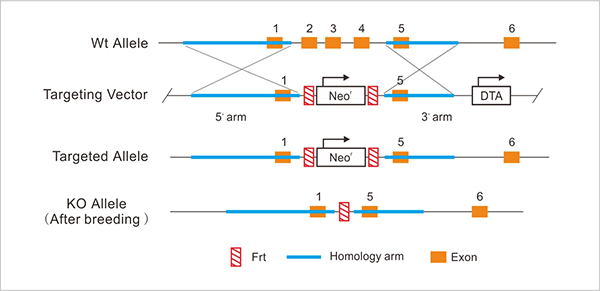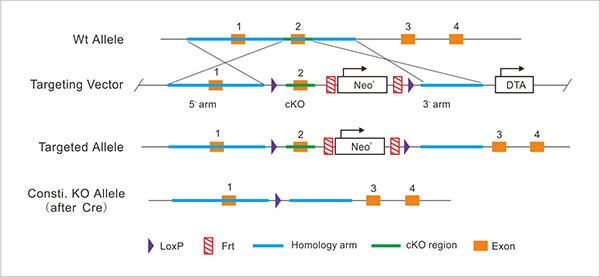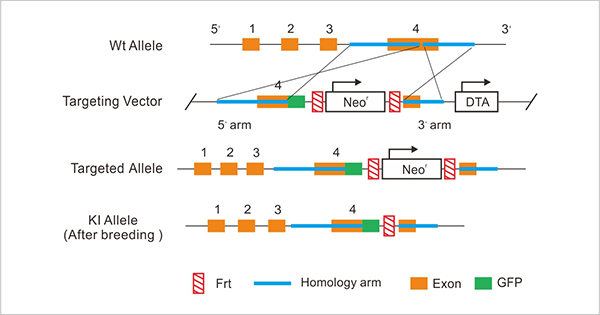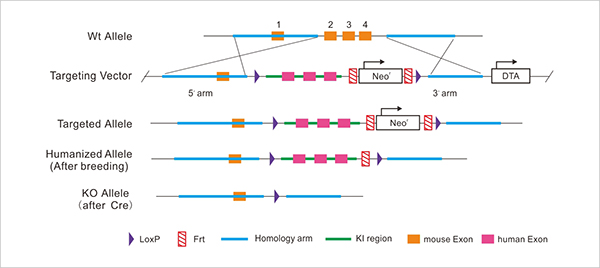

Get Your Conditional Knockout & Knockin Mice in as Fast as 6 Months!
Our new TurboKnockout® service can provide you with conditional knockout, reporter knockin and humanization mouse models as fast as 6-8 months. This proprietary gene targeting method is enabled by two innovations:
(1) A super competent ES cell line that generates 100% ESC-derived founder mice rather than chimeras, eliminating the need to screen for germline transmission.
(2) A selection cassette on the targeting construct capable of removing itself after ES cell targeting without the need to breed to Flp deleter mice.
These innovations eliminate two generations of breeding, shortening production time by 4-6 months as compared to industry standard. For conditional knockouts, it may be possible to breed founders directly to your tissue-specific Cre mice.
All projects are backed by our full money-back guarantee – no animals, no charge!
Each full gene targeting project is split into the following phases:

1. TurboKnockout® strategy design
2. TurboKnockout® vector construction
3. Targeting in ES cells
4. TurboKnockout® mouse production
| TurboKnockout | Traditional Gene Targeting | Cyagen CRISPR/Cas Gene Targeting | |
| Turnaround time | 6-8 months | At least 12 months | 5-9 months |
| Approach | Homologous recombination in ES cell by Cyagen TurboKnockout® technology | Homologous recombination in ES cell by traditional technology | CRISPR/Cas nuclease mediated gene targeting by pronuclear injection |
| Potential off-site targeting effects | No | No | Yes |
| Applications | Conditional knockout knockin Humanization |
Conditional knockout knockin Humanization |
Global knockout Point mutation knockin |
| Screening method | PCR | PCR | PCR + sequencing |
| Ability to introduce Large Fragment | Yes | Yes | No |
| Germ line guarantee | Yes | Yes | Yes |
In conventional knockout models, one or more critical exons of the target gene are replaced with a drug-selection cassette. This results in the permanent inactivation of the target gene in all cells of the body throughout development.

In conditional knockout models, one or more critical exons of the target gene are flanked by LoxP sequences which can be recognized by Cre recombinase. By breeding these floxed mice (mice with gene locus flanked by LoxP) with tissue-specific Cre-expressing mice (Cre deleters), it is possible to specifically delete the floxed region and inactivate the gene in desired tissues, while in all other tissues, the target gene remains functional.

By introducing point mutation(s) into homology arms or the targeting vector, desired mutation(s) can be incorporated into the target gene. The mutated gene is expressed under the control of the wildtype gene regulatory elements. Similarly, a visually detectable marker gene (such as GFP or lacZ) can be knocked into a gene locus to replace the coding sequence of the target gene for the purpose of monitoring the promoter activity of the gene. Alternatively, a marker or an epitope tag can be knocked into the end (or less frequently, the beginning) of the coding sequence to form a fusion protein, allowing target gene expression and localization/trafficking to be examined.

A humanized mouse is defined as a mouse model in which a portion or the full mouse gene sequence has been replaced by its human counterpart. The human gene is expressed under the control of the wildtype mouse regulatory sequences. Humanized mouse models have been used in immunology, cancer research, drug discovery, transplantation research, infectious disease research, and other fields.

The KO-first allele is flexible and can produce reporter knockouts, conditional knockouts, and null alleles following exposure to site-specific recombinases Cre and Flp. Knockout-first alleles can also be readily modified in cells using dual recombination-mediated cassette exchange. This strategy relies on the identification of a 'critical' exon common to all transcript variants that, when deleted, creates a frame-shift mutation.

Cyagen offers the best guarantee in the industry – we will fully refund the client’s service fee if animals with the specified genotype are not generated (except for genetic modifications severely affecting viability, morbidity, or fertility). Given the complexity of biological systems, a particular genetic modification may not result in the desired phenotype. As such, Cyagen's guarantee covers the creation of animals with the specified genotype, not a particular phenotypic outcome in terms of transcription, protein/RNA function, or organismal biology.